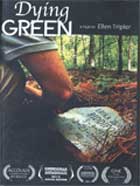
Dying Green 2011
Distributed by Green Planet Films, 21 Columbus Ave. Suite 205, San Francisco, CA 94111; 415-377-5471
Produced by Ellen Tripler
Directed by Ellen Tripler
DVD , color, 27 min.
Sr. High - General Adult
Death and Dying, Environmental Studies
Date Entered: 04/24/2013
Reviewed by Sara Parme, Digital Services Librarian, Daniel A. Reed Library, SUNY FredoniaWestminster, South Carolina is a conservative town with “a long tradition of tolerating eccentrics.” One of these personalities is Dr. Billy Campbell, the town’s only physician. Inspired by a middle school teacher who told the class when he died he wished to be buried in a burlap bag with a tree planted over him, and a college girlfriend taking classes in death studies, Campbell’s goal is two-pronged: green burials and land conservation. Dying Green explores Dr. Campbell and the memorial nature preserve, Ramsey Creek.
Dr. Campbell argues that today there is a disconnect with death. Death has been “professionalized, families have become spectators.” Death and dying has moved out of the home and into the hospital and funeral home, with strangers taking care of these final acts. And his practice of burial isn’t just advantageous because it’s cheaper or more environmentally friendly, but allows the community to take back the ritual of burying their dead.
The land conservation aspect of this film gets a bit buried, no pun intended, by the unusual sight of dead bodies wrapped and being handled in nothing but a shroud (and not always in a super graceful, practiced way). But, as Dr. Campbell points out, this way of ‘green’ burial (no embalming, no coffin or casket, with the community taking care of the body preparation and burial) isn’t new. Rural communities have been doing it since the beginning of time, by necessity. In fact, the chain-linked fences and pea-gravel cemeteries that are common today are what’s ‘unnatural.’
Ramsey Creek Preserve, a nature preserve, burial ground, and, with a restored old country church, a wedding site, is as much about life as it is death. And like all good documentaries, Dying Green explores too many aspects of life (and death) to sum up in a few paragraphs. Part history of American burial practices, part eco-doc, part small town story; at only 27 minutes, Dying Green is a quiet, inoffensive film. Filled with the noises of nature, the film meanders purposefully like the babbling brook on the preserve. It’s a shame the filmmakers leave some of the more powerful statistics until the end credits. Viewers may have to get past their own hang-ups with death to watch this, but the documentary directly addresses these and reminds you that embalming doesn’t keep bodies preserved for the rest of time, like some people prefer to think.
Dying Green explores a unique aspect of the green movement. Therefore, the audience, or the educational situation in which this would be viewed, is hard to define. But it’s broad enough to be interesting to most adults.
Awards
- Accolade Competition Winner, Greenville Film Festival
- CINE winner Golden Eagle Award 2011